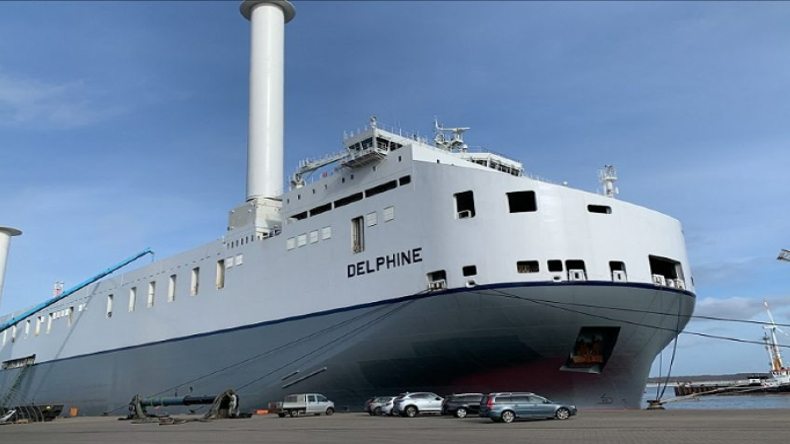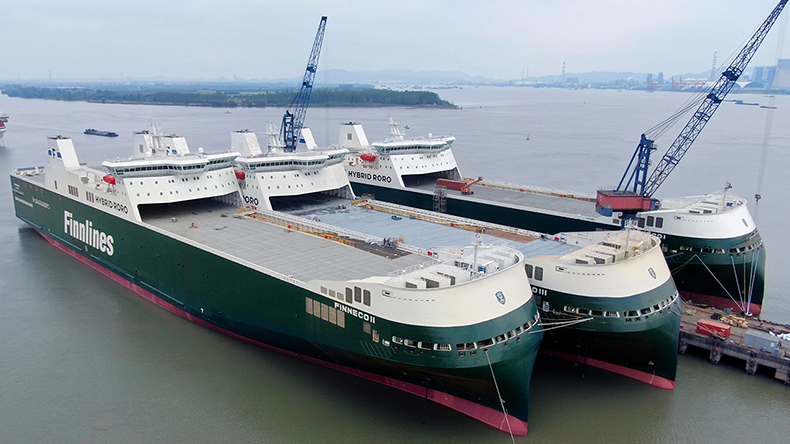Europe’s ro-ro cargo ship sector well prepared for decarbonisation
Leading ro-ro cargo vessel operators are overcoming market challenges while considering their decarbonisation strategies
European ro-ro cargo companies face shifts in trade patterns and a switch to more unaccompanied trailer movements
THE European ro-ro cargo vessel sector has been juggling rising costs and trade disruption caused by Brexit and the situation in Ukraine at a time when it is having to seek long-term decarbonisation solutions.
“In general, the main challenges for the sector this year are high costs, particularly for fuel and labour,” CLdN RoRo chief operating officer Gary Walker told Lloyd’s List. “While prices have come down from the very high levels seen in mid-2022, the market remains quite volatile. The implementation of the European Union’s Emissions Trading Scheme is also something that the marine sector is preparing to implement.”
Luxembourg-headquartered CLdN RoRo is the world’s second-largest operator of shortsea ro-ro cargo ships and operates 36, mostly owned, vessels in services between Benelux countries to Denmark, Portugal, Spain, Sweden and the UK.
Last year it added additional services to its network, and eight modern ro-ro ships, following the acquisition of Clipper Group’s Seatruck Ferries UK–Ireland operations.
Mr Walker said the European ro-ro sector is witnessing a continuation, and even an acceleration, of the trends that have been prevalent in the sector for several years, in particular since the pandemic and the UK’s exit from the European Union.
“The demand for unaccompanied freight has been increasing year on year against a backdrop of falling freight volumes between the UK and Europe,” he said. “This trend is also exacerbated by the lack of truck drivers and customers seeking the lowest carbon transport option by bringing goods closer to their end destination by ship and avoiding road miles. We are also seeing more interest in longer routes, for example to Iberia and Scandinavia as customers seek to reduce the cost and emissions profile of their cargo. The war in Ukraine has also had an impact in terms of inflationary pressure and on fuel prices.”
CLdN RoRo is expecting growth in cargo volumes during 2023 in several markets. It recently launched new direct services to the north east UK port of Teesport from Zeebrugge and Rotterdam, while adding capacity on its core service to London Purfleet.
These developments have been partly driven by the switch of cargo carried in accompanied trailers routed via the congested port of Dover, on passenger ferries, to unaccompanied trailers moving on pure ro-ro cargo vessels. At the same time CLdN has been using its purchase of Seatruck to enter new markets.
“The acquisition of Seatruck last year has extended our reach on the Irish Sea and offers us greater flexibility, for example to tranship cargo from Spain via Dublin to Liverpool. The integration of Seatruck is working smoothly and we are already seeing benefits,” said Mr. Walker.
The purchase has also provided the company access to land at the port of Liverpool that may be used to further develop CLdN’s activities in the UK market.
Other developments in European short-sea ro-ro trades recently has been the normalisation of vehicle production following the semi-conductor production crises of 2021 and 2022. This has driven an expansion in the export of cars shipped on ro-ro cargo ships.
Denmark’s DFDS, the world’s largest operator of shortsea ro-ro cargo tonnage, has been more directly affected by developments caused by the Ukraine situation as it has a number of services operating in the Baltic and Eastern Mediterranean trades.
“The Mediterranean trades remain relatively stable vs 2022 and are expected to continue to be supported by nearshoring of manufacturing closer to European end markets,” said Anders Refsgaard, a vice-president at DFDS. “A slowdown in Europe could lower demand for Turkish exports. In northern Europe, activity levels are challenged by the war in Ukraine, which impacts Baltic Sea volumes negatively.”
Mr Refsgaard said that its English Channel cargoes, which are mostly carried on DFDS’s ro-pax ships are decreasing due to some slowdown in the UK economy and negative impacts on trade from Brexit. However it expects its North Sea services, from Scandinavia to Benelux countries and the UK to remain “quite” stable.
While market prospects for the ro-ro cargo sector for the remainder of this year appear mixed, the major operators in the sector are considering more options for alternative fuels following the implementation of various ship efficiency measures in the past two years.
“Two decarbonisation regulations that will clearly influence the shortsea ro-ro cargo sector are the International Maritime Organization’s Carbon Intensity Indicator and the EU’s Emissions Trading System,” said Hans Eivind Siewers, segment director of ro-ro at leading ro-ro cargo ship classification society DNV.
CII rates ships between A-E, depending on their CO2 emissions as reported to IMO’s Data Collection System.
“Even though the enforcement of this regulation does not seem to bring high consequences in the first years, consequences could be higher on the commercial and contractual side, asset value and environmental, social and governance,” he said. “Then, if operating in the EU, starting from next year they will also have to pay for the CO2 they emit. We see exposure to this cost vary a great deal, but it can be significant.”
What is not always understood is that this cost will hit the document of compliance holder but will need to be transferred ultimately to cargo owners.
“Depending on cargo contracts, all parties including the DOC holder, operator and cargo owner will need access to a transparent system and verified emission data for this to work. We are introducing such system to our clients as we speak.”
Meanwhile all operators are considering which fuel will be the right choice for the future.
“The problem is that nobody has the answer on this and it will probably not only be one fuel. For the existing fleet, the choice will in most cases have to be some kind of biofuel. Many operators are already testing out this,” said Mr Siewers.
Most of the major operators, including CLdN and DFDS, adopted a strategy of investing in larger newbuildings in the past decade which operate at lower service speeds than earlier generation vessels in an effort to reduce emissions per tonne-mile.
“This strategy is paying off and we are now the clear leader on the routes we serve for CO2 efficiency,” said Mr Walker. “Over the years we have developed a very systematic and technology-based approach to fleet management to enhance efficiency including optimised sailing speeds, hull cleaning, coatings and crew education etc which are elements that also help improve our performance.”
The company’s last newbuilding deliveries, the 5,000 lane metre capacity Faustine (IMO: 9889708) and Seraphine (IMO: 9889710) delivered in 2021 and 2022, respectively, were the first large shortsea ro-ro cargo ships to be delivered to dual-fuel liquefied natural gas specification.
An earlier pair of ships, the 8,000 lane metre Delphine (IMO: 9789245) and Celine (IMO: 9789233) were specified as LNG-ready.
“Now that LNG prices have come back to more competitive levels, it is once again a viable consideration for our vessels that are LNG-ready,” Mr Walker said.
Delphine was recently retrofitted with a rotor sail supplied by Norsepower, which is an effective way to reduce fuel consumption. Depending on area of operation, rotor sails can reduce CO2 emissions for a ro-ro cargo ship by 10%. CLdN is currently analysing the potential benefits on board Delphine on its regular service between the UK, Ireland and mainland Europe.
CLdN has ordered a pair of 8,000 lane metre capacity newbuildings from South Korea’s Hyundai Mipo Dockyard which will feature a propulsion system that can operate as dual-fuel LNG or as gas/diesel-electric. They will be fitted with a Wärtsilä hybrid electric system which will permit CO2 emissions to be minimised and are set for delivery during late 2024 and early 2025.
 CLDN’S DELPHINE WAS RETROFITTED WITH TWO NORSEPOWER ROTOR SAILS IN FEBRUARY,
CLdN
CLDN’S DELPHINE WAS RETROFITTED WITH TWO NORSEPOWER ROTOR SAILS IN FEBRUARY,
CLdN
DFDS is evaluating future fuel types for its vessel fleet but in the meantime has undertaken a number of efficiency initiatives which include advanced anti-fouling paint and fuel injection system enhancements which reduce fuel consumption.
“Our vessels run on diesel oil or heavy fuel oil,” said Jesper Aagesen, director of sustainable fleet projects at DFDS. “In three ports, we do have shore power serving four vessels, and we are confident that more vessels will use shore power during port stays in the coming years. For alternative fuels, it is likely that we in the coming years will have methanol-fuelled vessels as retrofit and or newbuildings and towards the end of this decade, we also expect that ammonia will have a role to play for our segment supplemented by electrification, especially on our shortest routes.”
Having concluded a big fleet replacement programme in the past year, DFDS does not have any immediate newbuilding orders.
DNV’s Mr Siewers considers that for newbuildings, shipowners have three choices in terms of fuel types for the road to decarbonisation.
“LNG is one choice and even though fossil LNG will only bring you part of the way it will definitely bring you a step down the decarb ladder. To take you further down, bio-LNG can be a solution for further decrease of emissions.”
There are understood to be ro-ro cargo vessel newbuilding projects now being considered with methanol which is seen as quite simple from a technical and operational aspect.
“The problem is that most methanol is produced from natural gas and there is currently very low availability of green, non-fossil based, methanol. But we believe this will come,” said Mr Siewers, who noted that ammonia is gathering interest as an alternative fuel type from other vessel sectors.
“This fuel has a great potential to be one of the green fuels for the future. However, it has not yet been tested on ships though several engine makers are working on their prototype. This will come within the next years. It will be of high importance how we handle the toxic aspects of this fuel.”



